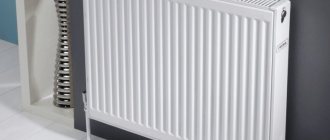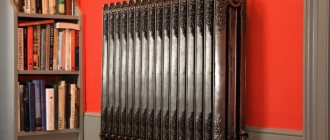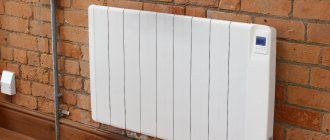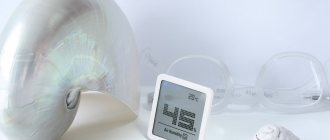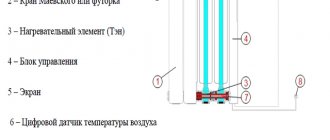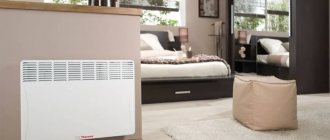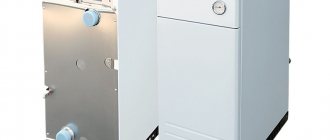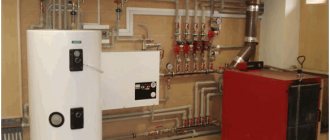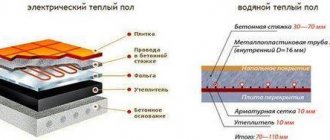Taking into account the peculiarities of energy supply to different regions of the country, we can conclude that not all villages use gas as the main type of fuel. Previously, it was mainly replaced by firewood or coal. But recently, solid fuels have begun to fade into the background, and electricity has taken the lead behind gas.
The thing is that manufacturers of electric heating devices began to offer so-called smart devices with which you can reduce the consumption of expensive electric current. Electric radiators fall into this category.
Device design
Anyone who sees this heating device for the first time notices its similarity to a conventional aluminum heating radiator, which is installed in a water heating system. In essence, this is true.
An electric radiator is a sectional aluminum battery into which a heating element is inserted. A heating element is installed in the lower cavity of the battery; the device must be equipped with an automation and control unit.
Plain water or technical oil is poured into the radiator. In the first case, the heating rate increases, in the second, the indicators of safe operation increase.
The most amazing thing is that, like regular sectional radiators, electric radiators can be built up in sections. True, in this case it will be necessary to increase the power of the heating element. The device is supplied with a Mayevsky faucet, a bottom plug, and an electrical cord with a plug for the socket.
How vacuum electric batteries work
A more economical option compared to oil-based electric batteries are vacuum radiators. Their work is based on heating a special liquid. located in the lower part of the aluminum case, easily evaporates and quickly distributes heat over the surface of the device. The peculiarity of the liquid filling the vacuum electric battery is its low boiling point - only 35 degrees C and a small volume - 500 ml.
The heat output of a vacuum electric battery is quite large - about 300 W for each section. When the battery is disconnected, it retains heat for a long time, because gas particles in a vacuum continue to move, although somewhat slower.
Vacuum electric radiator is a good option for economical heating
The set of heating devices includes emergency shutdown sensors and temperature regulators. The positive aspects of using vacuum radiators include:
- Easy installation;
- No need for auxiliary equipment;
- Nice design;
- Autonomy;
- Ability to regulate temperature in a wide range - 20-70 degrees C.
Attention! As a disadvantage, it should be noted that the vacuum battery cannot be tilted. It should stand on a perfectly flat surface
Main advantages
Like all electric heating devices, electric radiators have an efficiency of 98-100%. The electricity used is converted into heat with minimal losses associated with the coolant.
Electric radiators do not require complicated installation. Usually their location is under the window. To do this, two brackets are installed under the window sill, on which the devices are hung. The most important thing is that there is an outlet nearby.
No piping or heating boiler. There are no pumps, no expansion tanks, or a large number of shut-off valves, as in a water heating system. And if we compare electric radiators with a water heating system, they are several times cheaper in terms of initial investment.
Heating a country house with electric convectors - theory, experience of the portal’s craftsmen
One of the options for organizing the heating system of a country house is the use of autonomous heat sources not connected by a common main line. If previously these were mainly oil radiators, today electric convectors are becoming increasingly common. Among FORUMHOUSE participants, this heating method is also quite popular, not only in dachas where people visit on weekends, but also in permanent residences.
What are convectors
Unlike oil radiators and similar devices, convectors heat the air not only directly around them, but throughout the entire room due to convection - the cyclical movement of cold and warm air masses. Cold air from below enters the device through the lower grille, heats up passing through the heating element, exits through the upper grille and rises to the ceiling, cools down, falls again and enters the heater. Some models also have a fan that forcibly accelerates the circulation process.
Device
The convector is based on a heating element (heating element) of a tubular, needle or monolithic type, located in the lower part of an aluminum or steel body. Despite the fact that the heating element itself can heat up above 100⁰ C, the maximum temperature of the body is 60⁰ C – it’s hot, but does not threaten burns. This feature significantly expands the scope of application: even walls made of timber or logs are not an obstacle to installing the heater. The device is configured and controlled using a mechanical regulator or an electronic display; the mechanical version is less reliable, but cheaper; the electronics are more expensive, but more advanced.
Convectors are characterized by maximum efficiency (about 100%), which is explained by direct heating of air without intermediate energy consumption for heating the coolant.
alex157FORUMHOUSE Member
All devices have efficiency, since you have decided on electric heating, then take into account the losses:
- Electric boiler -> coolant -> wiring -> radiators -> air heating.
- Oil radiator -> coolant -> radiator -> air heating.
- Convector -> air heating.
The choice is yours.
In addition, the heater can also be set to maintain a certain temperature, and it will operate in a given mode, turning on as needed, which significantly reduces energy consumption. During periodic visits to the dacha, the convectors are set to the “anti-freeze” mode (maintaining a minimum air temperature) and “stoked” upon arrival. If we are talking about branded models with programmers, then you can set the temperature increase on a certain day before arrival. There is also the possibility of remote control; it is discussed in detail in the corresponding topic on the forum.
The power of the devices varies over a wide range, which allows you to select a suitable unit based on the capabilities of the network and the square footage or volume of the room. As in the situation with any other heat sources, it is advisable to get 1 kW of heat per 10 m², provided that the house is well insulated.
Varieties
Another advantage of the devices is their versatility - they can be wall-mounted, floor-mounted or even built-in. The latter are less popular and are most often used to create a thermal curtain over the entrance or panoramic windows. Some models of wall-mounted convectors can function as floor-mounted ones if you purchase and install additional legs. They also produce miniature baseboard heaters, the height of which is around 15 cm. Regardless of the type, all modern convectors have a presentable appearance, there are even original, black devices, but the majority are still white. The most common form is a thin, smooth rectangular panel with straight, beveled or rounded corners. The location of the mechanical relay or display varies by manufacturer.
Installation and operation
Consumers are attracted not only by high efficiency, a large selection of modifications and decorative features, but also by ease of installation and maintenance. Even wall-mounted appliances do not require wall slitting and global transformations, but are mounted on ordinary brackets; floor-mounted ones can be moved throughout the house.
Due to the nature of the air intake, it is not recommended to hang convectors too low, unless it is a special model for panoramic windows. First of all, this will entail unnecessary expenses.
AndreyZabolotkyFORUMHOUSE Member
If necessary, you can mount it 10 cm from the floor. It’s just that the lower you hang the convector, the greater the discrepancy between the readings on the convector thermostat and the actual room temperature. The only thing is that there is no need to install it “in the floor” - the air intake from the convectors is implemented from below.
Despite the fact that the power is selected based on the square footage (in country houses - from the volume), it is more effective to use several devices to cover the needs of the room.
AndreyZabolotky
For a room with an area of 20 m², two kilowatt convectors will be more effective - they will work in pairs, and each will be guided by the ambient temperature in its installation zone.
As for control, it’s not a problem to set up two or three convectors, periodically tightening the regulator or setting a program on the display, but when there are more than a dozen of them in different rooms or even on different floors, it’s advisable to try group control.
EnstoBTForumHouse Member
If you need regular group control, then you can connect the convector power line through a contactor of the appropriate rating, a 220 V coil, supplying it with control voltage from a thermostat with the necessary sensors and the necessary control. In the rooms, convectors will maintain the temperature in accordance with the setting on their thermostat.
Since suburban electrical networks are even less likely than urban ones to boast a stable voltage, and convectors, especially those with electronic “filling,” need 220 V for normal operation, and not as much as the socket will squeeze out, it is worth connecting them through stabilizers.
Alexey GlukhovForumHouse Member
A constant problem is that the voltage drop in winter, in cold weather, when everyone turns on powerful boilers, drops below 100 V. Even if there is 150-160 V in the outlet, the convector begins to work worse, the wire and plug get very hot. It turns off less often because it is more difficult to warm up the air with a reduced voltage, that is, it threshes almost constantly. That is why I installed three stabilizers - one per phase, operating from 90 V.
Some models have built-in stabilizers, but they are more expensive than installing an external device on a budget device.
Flaws
Like all other heating options, heating with convectors has its drawbacks. The fact that heating with electricity is one of the most expensive methods has been discussed more than once, but the real costs of heating will depend not only on the price of 1 kW of heat. Considering that convectors do not require the creation of piping, like an electric or solid fuel boiler, the costs of their purchase and installation will be significantly lower. In a well-insulated house, even heating with convectors will not require exorbitant costs, and if there are drafts, you can actually “fly out of the pipe” with gas. To verify the possibility or impossibility of heating with convectors, it is worth making a heat calculation based on your specific conditions, as well as estimating all the costs of creating various systems.
Accusations of convectors burning oxygen are refuted by one of the portal participants involved in their production.
EnstoBT
Electric convectors do not burn oxygen; oxygen does not burn under normal conditions.
But convectors can dry out the air somewhat, lowering the humidity, especially if a powerful device is installed in a small room or has a built-in fan. When you can’t afford a model with a built-in humidifier/ionizer, you can buy an external humidifier and solve the problem as it arises, if you really start to feel dry.
Electric convectors are only one of the options for heating a country house, with its own advantages and disadvantages, but it has a right to exist. The choice is yours.
If you decide to heat with convectors, which manufacturer to choose and why - in the topic on the forum - “Help in selecting convectors...”. Preference for a warm floor - an interesting variety of it - infrared, film or cable, attracts liquid coolant - article about the TP system on the ground. The video talks about built-in convectors in addition to the main heating system.
Economic side of the matter
As for saving energy, won't it be expensive in terms of electric current consumption? Since electric heating radiators are the most modern heating devices, it is necessary to say that manufacturers have taken care of the economic side of the issue.
Material of manufacture
Electric radiators are made of aluminum. And this is a metal with the highest thermal conductivity - 230 W/m K. For comparison, the thermal conductivity of polystyrene foam is 0.035 W/m K. That is, it turns out that the temperature of the coolant is immediately transferred to the air in the room through the aluminum sections. The losses are insignificant: the coolant temperature is +80 °C, the temperature of the outer plane of the radiator is 78-80 °C.
Automation
The device itself is equipped with automation, with which you can set the temperature inside the room. That is, the electric batteries heat up to a certain point, then turn off until the temperature in the room drops to the set value.
Based on reviews from many consumers, we can conclude that if you correctly set the temperature of the device, then 60% of the time it works in normal mode, and 40% in the off state. So much for huge energy savings.
Reducing the cost of products
Manufacturers have begun to realize that the use of expensive materials in the production of electric radiators is turning off many consumers. After all, the price of such a heating device is not the lowest. For example, some models and brands are no longer made from aircraft-grade aluminum, which can withstand high pressure (up to 80 bar). It just doesn't make any sense. After all, the pressure inside the device is minimal.
Some manufacturers produce electric radiators using a bimetallic design. This again increases the cost of the product. If they use mineral oil, then bimetal is not needed at all.
Infrared wall batteries for a private home
The operating principle of IR heaters is based on heating solid objects in the room, rather than air; they come in three modifications:
- low temperature;
- high temperature;
- film
Low-temperature infrared heaters have the shape of a panel that can heat up to 85 degrees. In them, the heating coil can be located inside the glass or protected by ceramics.
High-temperature installations are equipped with a heating element, which is placed in a tube made of heat-resistant glass. They are also equipped with a reflector that directs heat in a certain direction. These IR devices consume a lot of electricity.
Film heaters are usually used when installing a heated floor system. Recently, consumers have been offered various options for decorative IR heating panels that look like paintings.
The use of a wall-mounted heating option has its own peculiarities. The reason is that an IR heater placed on the wall will only heat objects that fall within the radiation zone. Therefore, to organize proper heating, such devices must be placed correctly.
It should be taken into account that when operating this type of heating, direct heating of surrounding objects occurs. The fact is that materials such as plastic and expensive wood do not tolerate such exposure well, as a result of which they may lose their original appearance.
It is also necessary to remember that when leaving the IR heating zone, a person will feel cold, which means that he will become uncomfortable in the room. For this reason, this heating method cannot be called the best solution for organizing the main heat supply option.
Makes and models
The modern heating equipment market offers a fairly wide range of electric radiators. There are both domestic and foreign brands here. Here are just the most popular:
- Effective Energy from St. Petersburg;
- KievEcoGroup;
- Teplokom, Russia.
These three manufacturers offer liquid-type electric heating batteries.
Efficient Energy
The liquid radiator model is called a Mini-boiler. This is an aluminum device from 3 to 10 sections, inside of which antifreeze is poured. The package includes an automation unit that provides 7 temperature settings. Plus, the device is equipped with a programmer, a Multitariff block and a sensor, with the help of which the heating temperature of the body of the device itself is controlled.
KievEcoGroup
This company produces a liquid model under the Eranova brand. This is the same aluminum radiator, consisting of 3-12 sections.
Additional options: programmer, cascade connection, Multitariff and Antifreeze.
Teplokom
The company produces one of the most popular brands of liquid radiators, Teplolux. There are several options in its model line, depending on the power of the heating unit itself. Eg:
- HLA-8R-B/ХР power 1200 W, sections – 8.
- HLA-12R-B/ХР power 1800 W, sections – 12.
Pros and cons of convectors
If you like an electric wall-mounted radiator more than others, then you should consider a convector, the operating principle of which is based on the laws of physics. As you know, cold air falls down, and here the equipment absorbs the flow into the lower grille. When they pass through the heating element, the temperature rises, the air becomes lighter and rises to the ceiling. The convection cycle will repeat again and again, and the continuous movement of air will create a comfortable temperature inside the room.
This electric wall-mounted radiator has heating elements and a metal body. The devices are supplemented with special timers, as well as automatic controlled thermostats. The convector does not burn oxygen, does not dry out the air, is safe, is easy to install and does not require human control. The only drawback may be the lack of a suitable place for installation.
Liquidless radiators
In the category of electric heating radiators, there is a group that includes completely unique heating devices. There is no place for coolant in their design. The housing itself is heated directly from the heating element, which is represented by the same heating elements.
Principle of operation
Many people mistakenly consider them convectors. Certain functions are similar, but the convector works on the principle of heating the air passing through the heating element. Liquidless electric batteries operate on a completely different principle.
Firstly, the heating elements are sealed into sections. They do not come into contact with air. Secondly, these designs use steel heating elements. Thirdly, it is possible to switch off each individual section, which leads to savings in fuel consumption.
In fact, this heating device is a sectional structure in which several heating elements are located. It turns out that the heating element immediately transfers heat to the body of the radiator itself without intermediaries.
Manufacturers
This group includes all three of the companies described above that produce electric radiators. For example, Effective Energy offers an Economy model. This is a radiator of 4-10 sections, each of which produces 150-200 W of thermal energy. The Premium brand offers additional options: remote control, 4 temperature settings, programmer.
Among the models in this group, a French manufacturer stands out, producing liquid-free electric heating batteries called Noirot. The company offers several models, but all of them do not exceed 1 kW in power.
The Italian Sira Group, the Norwegian company Nobo, appliances from Finland Ensto, and a number of other brands are all present on the Russian market. The choice is actually considerable. Each manufacturer has its own set of options, but all models are similar in functionality.
Oil-type wall-mounted electric heaters
Oil-type wall-mounted electric heaters have a sealed housing made of steel, which contains mineral oil and a tubular-type electric heater. They work on an extremely simple principle: hot oil heats the metal, and the thermal energy emitted by it gradually warms the air and the wall. Heat is reflected from the wall and spreads throughout the room.
Almost everyone knows about these devices. They are characterized by a long service life, affordable cost and noiselessness. The body of this device does not heat up, therefore, it dries the air in the same way as simple water batteries, but no more.
Of course, they also have disadvantages, including their impressive weight, which makes installation difficult on some types of partitions, as well as the fact that the room is heated rather slowly. It is not advisable to install oil-type devices in bathrooms, or leave them unused in country houses.
Electricity consumption
This indicator should be considered in two groups. The power of liquid heating devices does not exceed 1 kW. Most often, manufacturers offer radiators of 500-800 W. This means that such a device will consume 20 kW of electricity per day. But if you configure it correctly, you can get a reduction of up to 12 kW.
With liquid-free ones it’s a little more difficult. Here the consumption per section is taken into account, which means that everything will depend on the number of sections present in the battery. Based on the fact that each section consumes 150-200 W, you can calculate the consumption of the radiator. Again, with the right setup, you can achieve a 40% reduction in consumption.
Key characteristics of electronic heating convectors
According to the method of installation and fastening, electric convectors are divided into two types:
Wall-mounted models have a height of about 45 cm, and floor-mounted models have a maximum height of 20 cm. Also, narrow and elongated floor-mounted radiators have high efficiency due to the fact that heat exchange with the environment occurs over their entire area.
However, along with this, wall-mounted radiators have a simpler design.
The key characteristics of electric convectors are:
- if the radiator has an automatic control function, there is no need to additionally monitor it;
- when the convector operates, the air quickly warms up and there are no drafts;
- built-in thermostat allows you to control the temperature and save energy;
- automatic control devices prevent the structure from overheating. You can also install the radiator on a surface made of any material;
- the presence of special protection against moisture;
- the maximum heating temperature of the structure’s body is 65 degrees, so there is no risk of injury from contact with it;
- modern ergonomic design of the structure, absence of sharp corners, safety of use and the possibility of installation even in a children's bedroom;
- air does not acquire an unpleasant odor when heated;
- There is no forced ventilation, so the radiator operates silently.
You can also find models of wall-mounted electric radiators on sale, which are equipped, in addition to wall mounts, with removable wheels or rollers. Such a heating device can be easily installed on the wall and can also be easily removed from it to be installed anywhere in the room. If the electric convector has a design that is only suitable for stationary installation, then the place where it will stand must be thought out precisely and in advance so that the design does not interfere in the future and can heat the entire room.
Each model of electric heating radiator has a different average service life. Basically, this term depends on how high the quality of the heating element is. For example, a heating element made in accordance with all norms and rules can work without problems for about 15 years or even longer.
Manufacturers generally indicate a product warranty period of at least 2 years. The heating element must be in a steel case, the quality of the metal must be excellent, and can withstand high temperatures, much higher than the temperature of the heating element during maximum hardening.
Remember that, despite the fact that the electrical system of such heating devices is quite simple, you should not assemble them yourself, even if you have experience in this field. Improperly assembled and launched homemade installations can lead to fire.
Types of electric heaters
The classification of electric heating devices is mainly related to the nature of heat transfer. On this basis they distinguish:
- fan heaters
- convectors
- oil heaters
- infrared heaters
Fan heater
This is an electric heating device, conditionally consisting of two parts - a heater and a fan. The principle of its operation is to pump air through a heating chamber or heating element with a fan. The heated air, “driven” by the fan, leaves the device at a certain speed and therefore spreads faster and more efficiently throughout the room. The heating elements can be various spirals, flat devices or heating elements - tubular heaters.
The device is equipped with a thermostat that turns it off when the set temperature is reached. In addition, it may include a fan speed control and a timer to set the operating time. This allows you to avoid overheating during prolonged use.
Convectors
Convector cross-section
In them, heat transfer is based on the phenomenon of convection. Convection refers to the mixing of layers, gases or liquids with different temperatures as a result of the influence of the earth's gravity on them.
Simply put, warm and lighter air rises, while colder and heavier air falls down. It turns out to be something like a vicious circle, in the center of which there is an electric radiator. The air moves around it. When it heats up, it rises, and when it cools down, it falls towards the radiator, and the whole cycle repeats.
These devices have automatic thermostats and timers. Water heating radiators work on the same principle.
Oil heaters
In these devices, the working fluid is oil. Such devices do not have open heating elements, so there is no combustion of oxygen and small dust particles.
In addition, oil has a high boiling point. Therefore, unlike water, it does not boil. All this together makes the use of oil electric heaters absolutely safe. All devices have standard adjustments and automation.
Infrared heaters
These are devices that heat not the air, as in other cases, but the surrounding objects. This happens due to electromagnetic waves of a certain frequency. What’s surprising is that the device itself remains absolutely cold.
This is still a fairly new type of heating, but its use is becoming wider.
Oil for oil heater
The question of what kind of oil is in the heater rarely has to be decided, since these devices are always hermetically sealed to prevent evaporation and leakage of the working substance. During operation, replacement is required extremely rarely.
If depressurization occurs, then adding oil will not be enough; first you need to repair the housing and solder the leak. After the seal has been restored and if there is a technological hole for filling the liquid, it is possible to refuel or change the oil.
You can pour various transformer, mineral automobile (transmission) and sometimes even used oils into the oil heater
It is important to remember that you should not mix oils of different origins in the radiator, because
An unpleasant reaction may occur (precipitate will form, the composition will thicken, etc.). Only substances of identical composition may be added. It is not recommended to do this on your own. It is better to carry out repair work in specialized service centers.
Advantages and disadvantages of oil heaters
Among electric heating devices, oil ones are the only ones that are called electric radiators. Oil heating has many advantages:
- does not dry out the air;
- radiators transfer heat mainly through thermal radiation;
- has a safe design;
- the surface almost never heats up above 50-60 o C;
- easy installation and management.
All this is true, but there are also disadvantages. The main thing is a fairly large inertia. Oil, which serves to transfer heat, has a high heat capacity. And until it warms up, the air will not begin to warm up. But this same property allows you to smooth out temperature differences when turning on/off.
The biggest problem is high inertia and low efficiency: too many heat transfer stages
The second disadvantage is that the safety and durability of the work depends on the quality of workmanship. An incorrectly designed structure can simply burst when heated, the seams are poorly sealed, and oil will leak. Therefore, buying cheap but unknown brands is a risky business.
